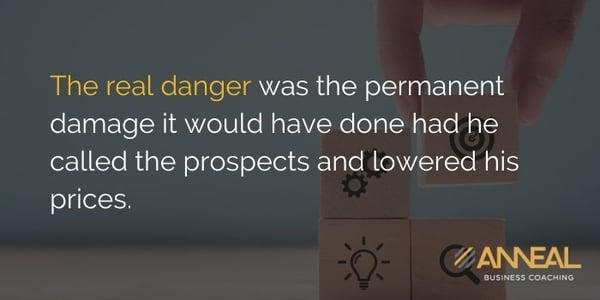I was Zooming with a client on a Tuesday a few weeks ago when he dropped the news on me: “Martin, I have over $350,000 worth of bids outstanding, but I haven’t sold anything for over two weeks. I think my prices are too high.” I could tell by looking that he was under stress. Now I knew why.
We had been working for almost two years to get his prices up and costs down, and he had improved his margins from 25% to 50%. It was great progress and it was working. Now all of his hard work was in danger of unravelling.
“Why do you think that?” I asked, “Do you have any real evidence that your prices are too high?”
“Yes. Two of my prospects told me my bid was higher than my competition.”
“Okay, but did they buy from the other guy? Have you actually lost any jobs to a competitor?”
“Not that I know for sure.”
“Well then, let’s just stay the course. You’ve been selling at the new prices. Let’s keep an eye on things and not be too quick to abandon everything we’ve been working on.”
To his credit, he agreed to let the bids stand as priced.
Four days later I was delighted to get a text message from him. He sold four of the jobs in just three hours on a Saturday morning.

My client dodged a bullet, and I don’t mean the money he would have lost to lower prices on the four jobs. The real danger was the permanent damage it would have done had he called the prospects and lowered his prices. He would have won jobs he was going to win anyway, but he wouldn’t have known that. Instead, he would have “proof” that his prices were too high and likely would have reduced his prices on all of his future bids. Who knows how much that could have cost him?
My father was a flight instructor before today’s navigation aids such as GPS. Back then, small-airplane pilots navigated using maps and a compass. They drew lines on a map, checked the wind, set a compass heading, and took off. They tracked their progress by checking off landmarks (towns, rivers, lakes, highways) as they flew over them.
Trouble would start if they failed to spot a landmark (often out of sight directly beneath the airplane). Doubt would creep in: Shouldn’t I be there by now? Have I flown past it? Maybe I’m not there yet, but shouldn’t I be? Maybe the wind blew me off course. Doubt led to second-guessing: Should I keep going on this course? Maybe I need to turn back and find the landmark. How much fuel do I have left? Turn which way? Left or right? Once our pilot turned off the pre-planned heading, he or she was truly lost. Doubt led to panic which led to serious trouble.

My father’s lesson to new pilots was: “Stick to the course and heading you planned back in the calm of the airport coffee shop.”
That’s my message regarding price changes made under duress: Stick to your planned course.